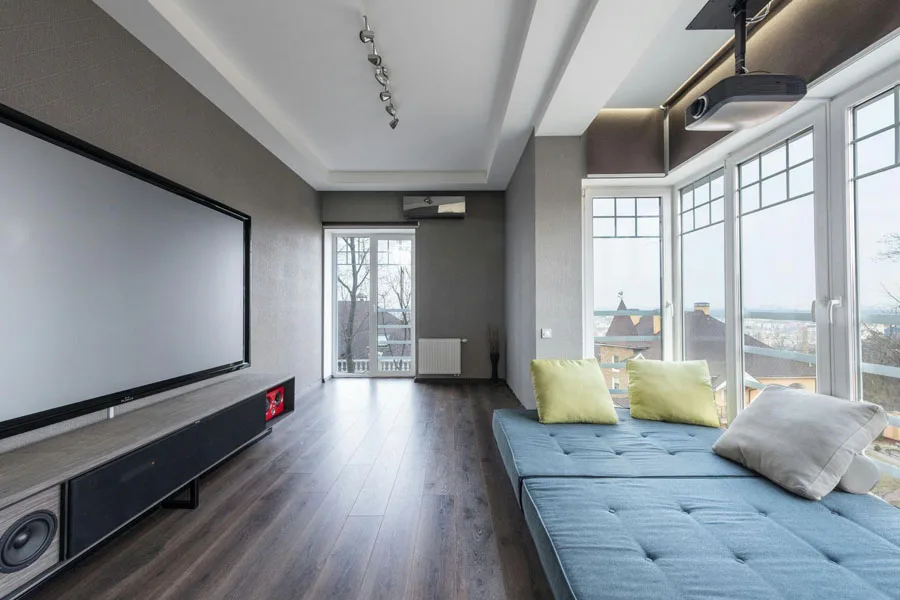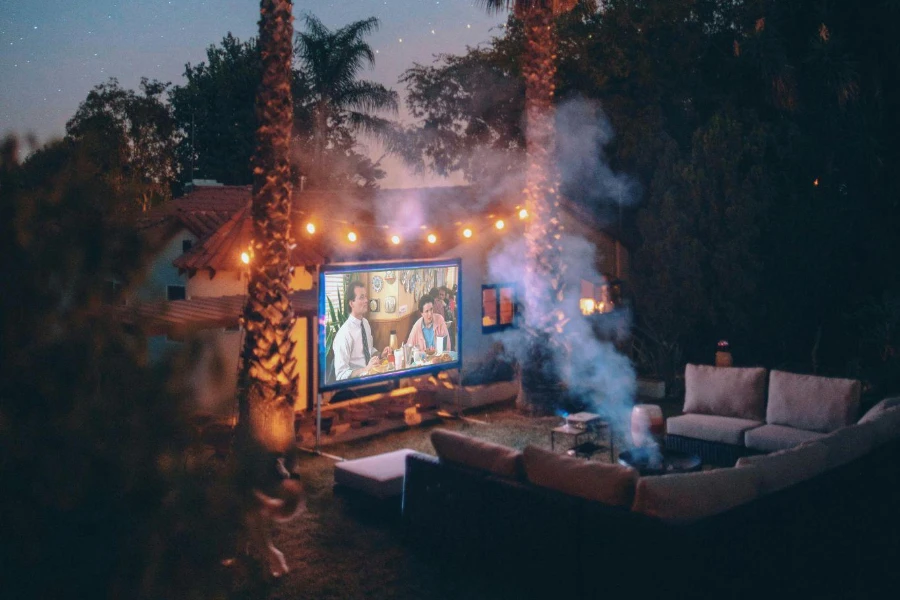In the realm of visual displays, the selection of a projection screen plays a crucial role in defining the clarity, impact, and overall success of presentations and storytelling efforts. These screens are not just surfaces on which images are cast; they are the canvas that can either elevate a visual experience to its peak or diminish its potential. For businesses and professionals tasked with curating top-tier visual setups, understanding the nuances of projection screen technology—ranging from material and size to the interplay with ambient light—becomes imperative. This understanding ensures that every presentation, whether intended for a boardroom, an exhibition, or any professional gathering, is delivered with unmatched quality, engaging the audience with unparalleled precision and vividness.
Table of Contents
1. Exploring the spectrum of projection screens
2. 2024 market insights: A projection screen odyssey
3. Decoding the secrets to projection screen perfection
4. Champions of the screen: 2024’s top contenders
5. Conclusion: Your passport to projection mastery
Exploring the spectrum of projection screens

A closer look at screen dynamics: The landscape of projection screens is as varied as the audiences and environments they cater to. Fixed screens, often favored for dedicated viewing spaces, promise a seamless and permanent solution for those seeking stability and a constant venue for visual engagement. Their immovable nature means a one-time installation, providing a consistent backdrop for crisp, clear images.
On the other end of the spectrum, pull-down screens offer a flexible alternative, ideal for spaces that serve multiple purposes beyond just viewing. These screens, capable of being discreetly stored when not in use, cater to environments where versatility is key. Similarly, motorized screens elevate the convenience factor, merging the retractable features of pull-down models with the modern touch of automation, allowing for smooth transitions with the press of a button.
Portability introduces a whole new dimension to projection screens. Portable screens are the nomads of the visual display world, designed for easy transport and setup. This category meets the needs of those presenting in various locations, providing a quick solution for professionals on the move. Whether it’s a presentation across town or a pop-up cinema under the stars, portable screens adapt to the presenter’s lifestyle, not the other way around.
Perfect pairings: Screens and settings. Selecting the right screen involves more than just matching sizes and spaces; it’s about understanding the interplay between screen characteristics and their intended environment. For boardrooms and professional gatherings where clarity and detail are paramount, fixed screens with a high gain material ensure that presentations are vivid and engaging, even in well-lit rooms. The choice of material, such as MaxWhite 2, known for its ability to reproduce true colors and maintain image integrity, becomes crucial in these settings.
Outdoor events or exhibitions, where ambient light can vary, demand screens with specific features like ambient light rejection. These screens are designed to maintain image quality even in bright conditions, ensuring that viewers enjoy a clear, unobstructed view no matter the setting.
Motorized and pull-down screens find their place in multi-functional spaces, where the need for a projection surface is intermittent. Their ability to retract and hide away makes them perfect for rooms that host both presentations and other activities, allowing for a clean aesthetic and functional versatility.
The decision to go for a portable screen hinges on the presenter’s mobility. For those who find themselves frequently transitioning between venues, the lightweight and easy-to-set-up nature of portable screens becomes a game-changer, offering a blend of convenience and quality that doesn’t tether them to a single location.
In essence, the selection of a projection screen is a deliberate choice that reflects not only the technical requirements of the projected content but also the physical and aesthetic demands of the spaces they occupy. Understanding the distinct features and advantages of each screen type ensures that every visual experience is optimized for its unique audience and setting, marking the difference between a mere presentation and a memorable visual journey.
2024 market insights: A projection screen odyssey

The global projector screen market was valued at USD 89,633.64 million in 2022 and is anticipated to expand at a compound annual growth rate (CAGR) of 16.72% during the forecast period, reaching USD 226,658.36 million by 2028. This significant growth is attributed to the increasing adoption of projector screens in both commercial and home use applications, driven by the demand for enhanced visual presentations and the growing trend of home theaters. The market’s expansion is further supported by advancements in screen technologies, including the development of electric, fixed frame, manual, and portable screens, each catering to specific viewing needs and environments.
Trendspotting in projection screen innovation: As we venture deeper into 2024, the projection screen market continues to evolve, driven by a blend of consumer preferences, technological advancements, and a relentless pursuit of clarity and convenience in visual displays. The trend toward ultra-high-definition visuals is pushing the envelope, with businesses and professionals alike seeking screens that can do justice to 4K and 8K content without compromise. This quest for quality is matched by an increasing demand for screens that offer flexibility and adaptability to various environments, from corporate boardrooms to outdoor venues, reflecting a shift towards more dynamic presentation and entertainment scenarios.
Innovation in screen materials and design is responding to these demands, with manufacturers introducing screens capable of delivering not just superior image quality but also enhanced durability and ease of use. The development of ambient light rejecting (ALR) screens is a testament to this trend, offering solutions that allow for clear, vivid images even in brightly lit conditions, a feature increasingly sought after in both professional settings and home theaters.
The technology transforming viewing experiences: Groundbreaking advancements are not limited to the visual aspect alone. The integration of sound permeable materials into projection screens is revolutionizing the audio-visual experience, allowing for speakers to be placed behind the screen without loss of sound quality. This feature is particularly appealing for immersive setups where space and acoustics play a crucial role in creating a seamless viewing experience.
Additionally, the rise of motorized and portable screens reflects a market that values convenience and versatility. Motorized screens, with their sleek design and remote-controlled retraction, are becoming fixtures in modern offices and homes, offering a blend of functionality and aesthetic appeal. Meanwhile, portable screens are gaining popularity for their ability to turn any space into a viewing area, catering to the mobile nature of presentations and outdoor cinema experiences.
As 2024 progresses, it’s clear that the projection screen market is not just about keeping pace with advancements in projector technology but is actively shaping the future of how visual content is experienced. With innovations aimed at enhancing every aspect of the viewing experience, from image quality and sound to flexibility and ease of use, the journey through the projection screen odyssey continues to unfold, promising exciting developments for professionals and businesses invested in leading-edge display solutions.
Decoding the secrets to projection screen perfection

The foundation of flawless imagery: Material and gain. The pursuit of perfect projection begins with the foundation upon which all images are cast: the screen material and its gain. A screen’s material is not just a backdrop but an active participant in image reproduction, affecting everything from brightness to color accuracy. Among the contenders, MaxWhite 2 emerges as a notable mention, celebrated for its ability to balance color vibrancy with detailed sharpness across wide viewing angles. This material exemplifies the industry’s strides toward screens that do not merely display but enhance the visual content. Gain, the measure of a screen’s reflectivity, further refines this process. A higher gain amplifies brightness, crucial for environments where controlling ambient light is not always feasible. Yet, it’s the delicate balance of gain with viewing angle breadth that sets a premium screen apart, ensuring luminosity does not come at the expense of inclusivity in audience placement.
Mastering size, aspect ratio, and the viewing experience: Equally critical in the alchemy of screen selection is the harmonization of screen size and aspect ratio with the projector’s capabilities and the spatial dynamics of the room. The mantra “bigger is better” is quickly dispelled by the nuanced understanding that an oversized screen in a compact room can distort and diminish the viewing experience. Conversely, a screen too small squanders the projector’s potential for immersive visuals. The aspect ratio, whether the widescreen 16:9 or the classic 4:3, should echo the predominant content format, avoiding unsightly letterboxing or image stretching. This alignment between screen and projector specifications, coupled with careful consideration of the viewing distance, culminates in a cinematic experience that is both immersive and comfortable, making every seat in the room the best one.
Conquering ambient light and installation challenges: Ambient light, the perennial nemesis of projection clarity, and the logistical hurdles of screen installation present the final frontiers in the quest for projection screen perfection. Innovations in screen technology offer solutions that defy the compromises traditionally associated with bright environments. Screens equipped with ambient light rejecting (ALR) properties stand as beacons of progress, maintaining image integrity even in well-lit conditions. On the installation front, the industry’s move toward user-friendly designs in motorized and portable screens addresses the demand for flexibility. Motorized screens cater to the elegance of modern spaces with their seamless integration and effortless operation, while portable screens champion the cause of mobility and adaptability, proving that high-quality projection is not confined to permanent setups. Together, these advancements in material, design, and technology mark a new era in projection screens, one where the only limitation is the viewer’s imagination.
Champions of the screen: 2024’s top contenders

The pinnacle of projection: Premium models unveiled. In the realm of premium projection screens, certain models stand out for their exceptional quality and innovative features. The Stewart Filmscreen Cima Neve, renowned for its superior image reproduction and luxury features, sets a high bar. Its ability to cater to the upscale home cinema room with customized options ensures an unparalleled viewing experience. Similarly, the Elite Screens Yard Master 2 emerges as a formidable contender, especially for outdoor enthusiasts or those seeking an impressive backyard cinema setup. Its robust design coupled with ease of assembly makes it a favorite among those who refuse to compromise on quality and versatility.
Excellence on a budget: Quality meets affordability. Navigating the landscape of projection screens with financial prudence doesn’t mean sacrificing quality. The VANKYO StayTrue Projector Screen exemplifies this balance, offering remarkable value without the hefty price tag. Its portability and ease of setup make it an ideal choice for casual viewers and professionals alike who seek a reliable screen for presentations or movie nights on a budget. This model underscores the industry’s commitment to delivering high-quality viewing experiences accessible to a wider audience.
The future is flexible: Portability and user-friendly designs. The demand for mobility and ease of use in projection screens has led to significant advancements in design and functionality. The Elite Screens Manual B epitomizes this trend with its sleek, user-friendly operation, appealing to those who prioritize convenience and aesthetics. Whether for a quick setup in a corporate environment or a home theater, this screen adapts to its surroundings seamlessly. Meanwhile, the Homegear motorized screen represents the pinnacle of convenience, combining the ease of a motorized system with a discreet design that complements any space. These models not only cater to the present needs of consumers but also point towards a future where projection screens blend innovation, flexibility, and user satisfaction.
As 2024 progresses, the projection screen market continues to evolve, driven by a blend of technological advancements and consumer expectations. From the luxury and bespoke offerings of premium models to the pragmatic, budget-friendly solutions and the surge in portable, user-friendly designs, the current lineup of projection screens caters to a diverse range of preferences and applications. These top contenders not only showcase the industry’s capacity for innovation but also its dedication to enhancing the viewing experience across the board, marking a new era in visual presentation and entertainment.
Conclusion
Through this exploration of the projection screen market, it’s clear that making an informed choice transcends mere preference—it’s about harnessing the right technology to elevate every presentation and cinematic experience. From understanding the critical role of screen materials and gains to selecting the appropriate size and navigating ambient light challenges, the options available in 2024 cater to every need. Premium models like Stewart Filmscreen Cima Neve and Elite Screens Yard Master 2, alongside budget-friendly and portable options such as VANKYO StayTrue, underscore the industry’s commitment to diversity and innovation. This guide serves as a beacon for professionals seeking to ensure excellence in every visual display, emphasizing that the right projection screen is indeed a key to mastering visual presentations in any setting.




